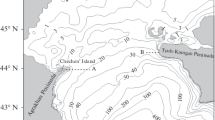Abstract
It is shown on the basis of the data of the Russian Academy of Sciences expeditions in 2003–2010, the historical CTD database, the WOCE climatology, and the satellite altimetry that the area of the Scotia Sea and the Drake Passage is even a greater significant orographic barrier for the eastward Antarctic Circumpolar Current (ACC) than was previously thought. It is the current concept that this barrier is the most important for the ACC; it consists of three obstacles: the Hero Ridge with the Phoenix Rift, the Shackleton Ridge, and the North Scotia Ridge with the relatively shallow eastern part of the Scotia Sea. Despite the fact that all three obstacles are permeable for the layer of the Circumpolar Bottom Water (CBW; 28.16 < γn < 28.26) being considered the lower part of the circumpolar water, the circulation in this layer throughout the Scotia Sea and the Drake Passage quite substantially differs from the transfer by the surface-intensified ACC jets. Herewith, the upper CBW boundary is the lower limit of the circumpolar coverage of the ACC jets. This result is confirmed by the near zero estimate of the total CBW transport according to the three series of the LADCP measurements on the sections across the Drake Passage. It is shown that the transformation (cooling and freshening) of the CBW layer, which occurs owing to the flow of the ACC over the Shackleton Ridge, is associated with the shape and location of the ridge in the Drake Passage. The high southern part of this ridge is a partially permeable screen for the eastward CBW transport behind which the colder and fresher waters of the Weddell Sea and the Bransfield Strait of the same density range as the CBW penetrate into the ACC zone. The partial permeability of the Shackleton Ridge for the CBW layer leads to the salinization of this layer on the eastern side of the ridge and to the CBW’s freshening on the western side of this ridge, which is observed across the entire Drake Passage.
Similar content being viewed by others
References
S. V. Gladyshev, M. N. Koshlyakov, and R. Yu. Tarakanov, “Currents in the Drake Passage Based on Observations in 2007,” Oceanology 48(6), 759–770 (2008).
M. N. Koshlyakov, S. V. Gladyshev, R. Yu. Tarakanov, and N. I. Ryzhikov, “Deep Currents in the Central Part of the Drake Passage Based on the Data of the 2008 Hydrographic Survey,” Oceanology 50(6), 821–828 (2010).
M. N. Koshlyakov, S. V. Gladyshev, R. Yu. Tarakanov, and D. A. Fedorov, “Currents in the Western Drake Passage According to the Observations in January of 2010,” Oceanology 51(2), 187–198 (2011).
M. N. Koshlyakov and R. Yu. Tarakanov, “Antarctic Bottom Water in the Pacific Sector of the Southern Ocean,” Oceanology 43(1), 1–15 (2003).
M. N. Koshlyakov and R. Yu. Tarakanov, “Antarctic Circumpolar Water in the Southern Part of the Pacific Ocean,” Oceanology 43(5), 607–621 (2003).
M. N. Koshlyakov and R. Yu. Tarakanov, “Water Transport across the Subantarctic Front and the Global Ocean Conveyer Belt,” Oceanology 51(5), 721–735 (2011).
R. Yu. Tarakanov, “Antarctic Bottom Water in the Scotia Sea and the Drake Passage,” Oceanology 49(5), 607–621 (2009).
R. Yu. Tarakanov, “Circumpolar Bottom Water in the Scotia Sea and the Drake Passage,” Oceanology 50(1), 1–17 (2010).
T. K. Chereskin, K. A. Donohue, D. R. Watts, et al., “Strong Bottom Currents and Cyclogenesis in Drake Passage,” Geophys. Rev. Lett. 36, L23602 (2009). doi: 10.1029/2009GL040940
V. Gouretski and K. P. Koltermann, “WOCE Global Hydrographic Climatology,” Ber. Bundesamtes Seeschiffahrt Hydrogr. 35, 1–52 (2004).
M. P. Meredith, C. W. Hughes, and P. R. Foden, “Downslope Convection North of Elephant Island, Antarctica: Influence on Deep Waters and Dependence on ENSO,” Geophys. Rev. Lett. 30(9), 1462 (2003). doi: 10.1029/2003GL017074
A. C. Naveira Garabato, K. J. Heywood, and D. P. Stevens, “Modification and Pathways of Southern Ocean Deep Waters in the Scotia Sea,” Deep-Sea Res. I 49(4), 681–705 (2002).
A. C. Naveira Garabato, D. P. Stevens, and K. J. Heywood, “Water Mass Conversion, Fluxes, and Mixing in the Scotia Sea Diagnosed by An Inverse Model,” J. Phys. Oceanogr. 33(12), 2565–2587 (2003).
A. H. Orsi, G. C. Johnsson, and J. L. Bullister, “Circulation, Mixing, and Production of Antarctic Bottom Water,” Prog. Oceanogr. 43(1), 55–109 (1999).
A. H. Orsi, Th. III. Whitworth, and W. D. Nowlin, Jr., “On the Meridional Extent and Fronts of the Antarctic Circumpolar Current,” Deep-Sea Res. 42(5), 641–673 (1995).
S. L. Patterson and T. Whitworth, “Antarctic Sector of the Pacific,” Elsevier Oceanography Series 51, 55–93 (1989).
H. A. Sievers and W. D. Nowlin, Jr., “The Stratification and Water Masses at Drake Passage,” J. Geophys. Res. 89(C6), 10489–10514 (1984).
W. H. F. Smith and D. T. Sandwell, “Global Seafloor Topography from Satellite Altimetry and Ship Depth Soundings,” Science 277, 1957–1962 (1997).
I. J. Smith, D. P. Stevens, K. J. Heywood, and M. P. Meredith, “The Flow of the Antarctic Circumpolar Current over the North Scotia Ridge,” Deep-Sea Res. I 576, 14–28 (2010).
S. Sokolov and S. R. Rintoul, “The Circumpolar Structure and Distribution of the Antarctic Circumpolar Current Fronts. Part 1: Mean Circumpolar Paths,” J. Geophys. Res. 114, C11018 (2009). doi: 10.1029/2008JC005108
T. Whitworth, W. D. Nowlin, A. H. Orsi, et al., “Weddell Sea Shelf Water in the Bransfield Strait and Weddell-Scotia Confluence,” Deep-Sea Res. I 41(4), 629–641 (1994).
T. Whitworth, A. H. Orsi, S.-J. Kim, et al., “Water Masses and Mixing Near the Antarctic Slope Front,” Ocean, Ice, and Atmosphere: Interactions at the Antarctic Continental Margin; Antarctic Research Series 75, 1–27 (1998).
Author information
Authors and Affiliations
Corresponding author
Additional information
Original Russian Text © R.Yu. Tarakanov, 2012, published in Okeanologiya, 2012, Vol. 52, No. 2, pp. 176–189.
Rights and permissions
About this article
Cite this article
Tarakanov, R.Y. The Scotia Sea and the Drake Passage as an orographic barrier for the Antarctic Circumpolar Current. Oceanology 52, 157–170 (2012). https://doi.org/10.1134/S0001437012010195
Received:
Published:
Issue Date:
DOI: https://doi.org/10.1134/S0001437012010195



